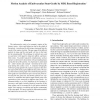Free Online Productivity Tools
i2Speak
i2Symbol
i2OCR
iTex2Img
iWeb2Print
iWeb2Shot
i2Type
iPdf2Split
iPdf2Merge
i2Bopomofo
i2Arabic
i2Style
i2Image
i2PDF
iLatex2Rtf
Sci2ools
ICCV
2007
IEEE
2007
IEEE
Motion Analysis of Endovascular Stent-Grafts by MDL Based Registration
The endovascular repair of a traumatic rupture of the thoracic aorta - that would otherwise lead to the death of the patient - is performed by delivering a stent-graft into the vessel at the rupture location. The age range of the affected patients is large and the stent-graft will stay in the body for the remaining life. The technique is relatively new, and no experience with regard to long-term effects, and durability exists. To predict long-term complications, such as ruptures or destructive interactions with surrounding tissue during the life of the patient, it is important to understand the - rather intense and constant - movement of the stentgraft during the cardiac cycle. A computed tomography with heart gating (gated CT) acquires sequences that show the region of the stent-graft at different time points. We analyze the motion of stent-grafts with a model based approach. Stent-grafts are represented as sparse sets of axis points extracted from the gated CT, and motion patterns a...
| Added | 03 Jun 2010 |
| Updated | 03 Jun 2010 |
| Type | Conference |
| Year | 2007 |
| Where | ICCV |
| Authors | Georg Langs, Nikos Paragios, Rene Donner, Pascal Desgranges, Alain Rahmouni, Hicham Kobeiter |
Comments (0)

